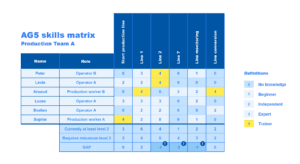Employee self-assessment: The basis of a skills matrix
Keeping it practical, in this article we’ll explain how self-assessment for employees can help them get recognized and why keeping track of staff skills and competences within a skills matrix can help managers make transparent operational decisions. Let’s start with the definition of employee self-assessment. Just as the name says, it’s a method used by employees to help them recognize...


Keeping it practical, in this article we’ll explain how self-assessment for employees can help them get recognized and why keeping track of staff skills and competences within a skills matrix can help managers make transparent operational decisions.
Let’s start with the definition of employee self-assessment. Just as the name says, it’s a method used by employees to help them recognize their current skills and competencies at the workplace, and also what they could improve on. Ultimately, the use of employee self-assessment is for companies to build upon the results it provides as a transparent skills management tool.
On the other hand, whenever you’re defining operating processes or putting together project teams, it’s always useful to know exactly which skills, competences, expertise, qualifications, and certification all your organization’s staff possess.
But what is a skills matrix?Copied
Skills matrices are great for displaying and keeping track of your staff’s core competences, skills, qualifications, and certification across your entire organization in a clear and organized fashion.
As the name suggests, they’re a record of each employee’s skills and qualifications in a matrix layout.
They’re principally used by HR and operations managers, team leaders, and project leaders. Matrices are virtually indispensable for companies that have embraced skill pool management philosophies. Using skills matrices, you’ll be able to instantaneously spot any weak links or vulnerabilities in terms of skills, as well as who has which qualifications and/or certification to carry out any particular task.
Competency vs skills self-assessments for employeesCopied
To be able to perform proper self assessment, employees need to grasp the differentiation between the two terms. Although they may seem similar, they have an entirely different level of meaning. Especially when it comes to career advancement or getting hired for a new role.
What are skills?
Skills are specific learned techniques that are required to perform a given job well. Examples depend on the specific role, ranging from handling accounts and coding to welding, or writing tenders.
However, there is a difference between hard skills and soft skills. A hard skill is a technical skill that a professional may demonstrate through their specific qualifications and professional experiences. Whereas a soft skill is a non-technical skill that is less established in specific trades.
Skill examples: Handling accounts, writing tenders, computer programming, and foreign languages.
What are competencies?
On the other hand, competencies are the person’s knowledge and behaviors that lead them to be successful in a job. Examples of competencies within a job role include the improvement of business processes, strategic planning, and data-based decisions.
Competency examples: Analytical knowledge, negotiation, problem-solving abilities, strategic planning, and data-based decision making.
Keep on reading as we delve further into the skills matrices behind self-assessment for employees and how they can help managers reduce operational risk by being in control of their staff skills.
How does skills self-assessment benefit employers?Copied
Skills matrices help determine a lot of things, mainly the suitability to certain tasks or job roles through individual employees skills, competencies and qualifications.
But how does it benefit employers to assess employees? By creating a system of skills assessment, it encourages employees to work harder and improve their skills greatly, resulting in an organization benefiting by time, skill, and loyalty invested by the employee to the company.
More importantly, it gives managers a broader perspective and an overview of planning accordingly and thus ensuring production continuity.
Self-assessment – the basis of a skills matrix explainedCopied
In reality, there are two ways of assessing your workforce skills. Managers and team leaders keeping track of their staff skills and competencies through training plans and audits is one way of doing it. On the other hand, some organizations prefer to allow their employees to perform self assessments themselves.
In a nutshell, a skills matrix is primarily used to keep a clear record of all employees essential skills, knowledge, and qualifications information in one place. This database proves vital whenever operational/project processes are being planned internally.
By using skills matrices you are ready to immediately detect liabilities in terms of sufficient employees’ skills, as well as who has certain qualifications or enough knowledge to sufficiently meet a competency map.
What should be included in a skills matrix?
A skills matrix visually presents a table of defined skills and knowledge that maps out employees capabilities for certain tasks/projects.
Making it easier for decision-makers, project leaders, and HR, to self-assess within the workplace.
To answer the question, this is what should be included:
- Down one column should be the employee’s names and their role within the workplace in another.
- There should be a ranking level column
- A total percentage column
- And an overall score rating column
Top tip: Make sure you check the free matrix template for more examples and guidance!
What type of decisions can be made based on employee self-assessment?Copied
Imagine your organization needs to identify critical tasks and requirements in preparation for an audit. Or maybe you have to deal with employees off sick or periods of peak demand, when finding replacements of experts within your organizations in a timely manner is crucial. In such an event, it’s important you respond effectively in order to safeguard productivity and continuity.
Through continuous self assessment in which employees enter information regarding their skills and qualifications, the skills matrix will display vital information for the precise skills needed to perform certain tasks.
Furthermore, a skills matrix can also be beneficial to a company when making decisions through monitoring a group or an individual’s progress. Thus the HR and Learning and Development departments will obtain direct concise data and insights to work with and improve upon.
Get going now!Copied
Self-assessment is a great way to gain better insights into your employees’ personal qualities and work-related personality traits. It reveals what their interests, strengths, and weaknesses are, which, in turn, benefits both the employee and your organization.
Want to learn more about how employee self-assessment can help a company align projects more efficiently through skills management? Take a dive into the world skills management world with the AG5 software and take your professional employee self-assessment to the next level.
Use AG5 to identify skill gaps
Say goodbye to Excel matrices. Start using AG5’s plug and play skill matrix software.
ISO27001 certified
Free trial available

